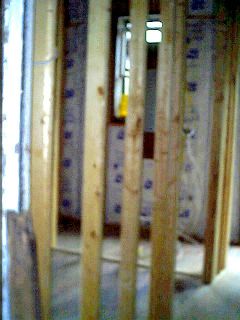We've had some good news in the last week. We've sought two second opinions regarding the value of our house upon completion. As I mentioned in a previous post, we believe that the bank's appraiser low-balled the value. Our second and third opinion are both 50%-80% higher than the original value. We may be able to leverage some more cash out of the Queen to finish this project. This has provided a small measure of hope.
Recently, I've been thinking a lot about our house's wood siding. This preoccupation is rooted in a couple problems confronting us on this project. First, our contractor has vanished and we are in the process of finding yet another one. If we don't have one come out soon, we will be forced to move three stacks of lumber to protect it from rain, bugs, and rot. That will probably eat up half to an entire day's worth of work, and I'd rather not have to do that. Second, even when (if?) we get all the siding up, we still have thousands of square feet of paint to scrape off the original house.
For those of you that haven't had to pleasure of scraping copious amounts paint, it is wonderful process that is never ending. My wife spent over three hours scraping off a single door jamb. We've tried heavy-duty chemical strippers, eco-friendly strippers, and a pressure washer. None have impressed us.
You can imagine our excitement when This Old House Magazine reviewed a new type of paint stripper, the
Silent Paint Remover. A herd of mutes with paint scrapers? Hardly! The Silent Paint Remover uses an ultra-violet light to heat and strip paint. It doesn't heat the paint to as high of a temperature as a heat gun, which can set your house on fire if you are careless or unlucky. It also strips all layers of the paint at once. First heat the area you wish to scrape for 15-30 seconds, then give it a quick couple of swipes with your scraper. The paint is gone and the wood is immediately ready to paint. Great, right? Yes, if you can afford it. The price tag for one of these wonders is currently $465.00 according to Viking Sales Inc., the manufacturer of the Silent Paint Remover.
At this point, we'd have to sell organs on the black market to get one of these. Then I discovered this website:
http://www.oceanmanorhouse.com/paintremover.htmlThis site is great! An electrical engineer disgruntled with the Silent Paint Remover's price tag figured out how to build your own for only $40-$100. He then published photos, schematics, and instructions of how to do it on his website. I'm currently scouring eBay and Lowe's for all the parts I need. Once I build it, I'll post how well it goes. Wish me luck.
So, why bother with wood at all?
Personally, I just prefer the look and feel of it. It has a character that I have yet to see duplicated with vinyl, concrete, masonite, et cetera.
Wood is also very versatile; with patience and the right tools you can make it do almost anything.
Vinyl, the current siding of choice it seems, while low maintenance, is not good for you or the environment. If you'd like more details, please go to
www.bluevinyl.org. In short, the process used to make it is highly toxic, it doesn't biodegrade, and it releases poisonous gases when burned (I can't remember what gas, but I believe that it is cyanide).
As far as I know, there is no way to recycle vinyl siding. If there is, it's not available in Arkansas. The Queen came clad in snazzy, mint green siding. To the shock of many, we striped all of it off the house. We've given most of it away, so it is being recycled in a fashion. The few scraps left will go to the landfill. I feel a bit guilty for this, but I haven't been able to find an alternative.
























